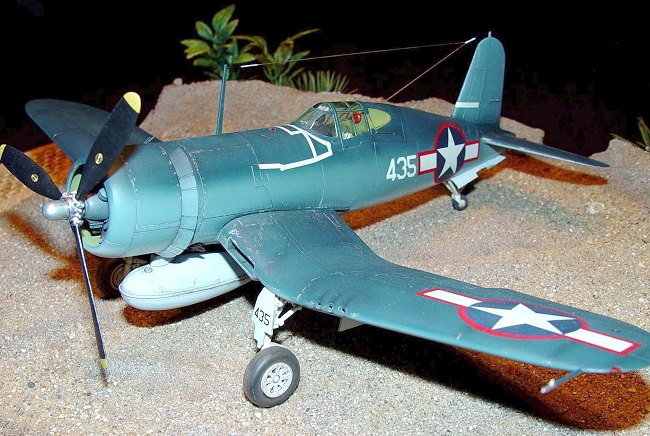
|
KIT # |
61046 |
|
PRICE: |
$24.99 MSRP |
|
DECALS: |
See review |
|
REVIEWER: |
Emilio Diaz |
|
NOTES: |
Andrea Aircraft Colors/Sky Decals used |

|
HISTORY |
Not much more can be said on the exploits of the pioneer use of the F4U-1 by the Marines, except that it was the right aircraft, at the right time, to turn the tide of the Pacific air war. It stemmed all efforts by the JNAF to regain control of the skies over the Solomon Islands during 1943.
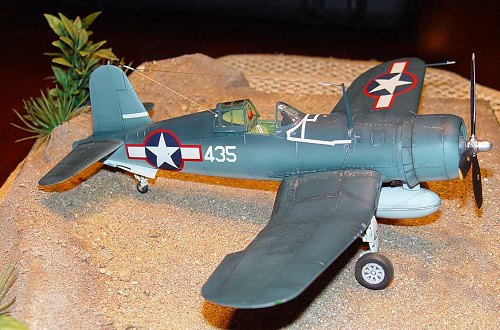 The Corsair was
flown by pilots who not only had to "learn on the job", but survive the
onslaught of Japan's elite air forces. Corsairs where hurriedly pressed
into the battle and emerged as the best all-round fighter in the Pacific
theatre of operations, racking up an 11 to 1 kill ratio.
The Corsair was
flown by pilots who not only had to "learn on the job", but survive the
onslaught of Japan's elite air forces. Corsairs where hurriedly pressed
into the battle and emerged as the best all-round fighter in the Pacific
theatre of operations, racking up an 11 to 1 kill ratio.
The Marines received the F4U's first because of early teething problems. This was due to the unstable landing characteristics discovered during carrier trials. With a nagging habit of dropping a wing and a high bounce when landing on deck, it became known as the "Ensign Eliminator" and was relegated to "land based" units.
Flying from the primitive airfields, hacked from the jungle, paid for in blood by their fellow Marines, these Marine pilots with their coral dust covered Corsairs, rose to the call and wrote their names in history. Guadalcanal, Munda, Vela Lavella and Bougainville where the places that the Corsair earned it's nickname from the Japanese, "Whistling Death"!
|
THE KIT |
Tamiya's rendition the Corsair ranks as one of the best ever produced by any company. It has been reviewed numerous times and is the "benchmark" that other manufacturers should follow. This kit allows someone to build a little jewel of a model that captures the looks and sit of the original. Tamiya provides a well-engineered kit with 124 parts in light grey plastic with lightly recessed panel lines.
|
CONSTRUCTION |
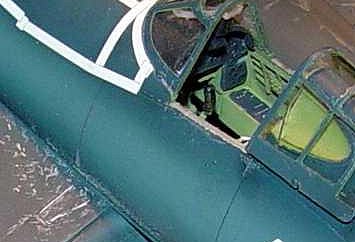 First of all, this
kit was built by two guys that are hard pressed for time, because of
commitments to family and occupation. Jim Jensen and I came up with a
novel solution to our lack of building kits recently. Jim built the basic
kit and I painted it and finished the construction.
First of all, this
kit was built by two guys that are hard pressed for time, because of
commitments to family and occupation. Jim Jensen and I came up with a
novel solution to our lack of building kits recently. Jim built the basic
kit and I painted it and finished the construction.
Jim chose to complete this model basically out of the box with little or no improvement, to keep the time to a minimum. There are some little problem areas, such as the seams in the middle of the flaps, but the kit is a quick and fun build. I then received the kit and tweaked it a little. The tail wheel was repositioned, the fairings removed from the tail gear doors and the pilot step filled in on the right flap. The kit was assembled with no other detail parts other than tape seat belts and "Spider Wire" for the radio aerials. I included the 165-gallon drop tank as this adds a little something to the model. The model then was masked using tissue paper for the cowling, wheel wells and express masks for the canopy. Then it was time for the fun part.
|
CAMOUFLAGE & MARKINGS |
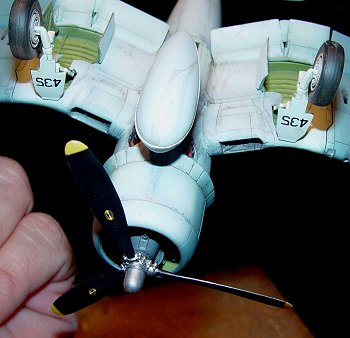 The model was
finished as a field painted Corsair belonging to VMF 225, based on Vella
Lavella, November 1943. I first preshaded the model with Tamiya black. I
used a combination of paints to get the finish I was looking for. Gunze
for the Dark Sea Blue, Tamiya for the Intermediate Blue and Andrea Toned
Down White for the underside surfaces. All colors where sprayed very thin
with a high pressure setting between 15 to 35 p.s.i., using a Co2 bottle
for air supply and a Badger dual action airbrush, building up the colors
from the panel line to center of the panel. This is where it gets tricky
as too little will not give you “the look" and too much seems
unrealistic. I then over coated the patchy look of the model with Andrea
toned down Aircraft colors till I got the look of light weathering. I
really like the Andrea paints, as they have very fine pigments that spray
better with a lot of thinner. This adds to the scale look of the model.
When I was satisfied with the basic colors, I coated the model with
Testor's Metalizer Sealer to prepare the model for decals.
The model was
finished as a field painted Corsair belonging to VMF 225, based on Vella
Lavella, November 1943. I first preshaded the model with Tamiya black. I
used a combination of paints to get the finish I was looking for. Gunze
for the Dark Sea Blue, Tamiya for the Intermediate Blue and Andrea Toned
Down White for the underside surfaces. All colors where sprayed very thin
with a high pressure setting between 15 to 35 p.s.i., using a Co2 bottle
for air supply and a Badger dual action airbrush, building up the colors
from the panel line to center of the panel. This is where it gets tricky
as too little will not give you “the look" and too much seems
unrealistic. I then over coated the patchy look of the model with Andrea
toned down Aircraft colors till I got the look of light weathering. I
really like the Andrea paints, as they have very fine pigments that spray
better with a lot of thinner. This adds to the scale look of the model.
When I was satisfied with the basic colors, I coated the model with
Testor's Metalizer Sealer to prepare the model for decals.
Decals are from Sky Models with the main insignia coming from the Tamiya F4U-1a kit. All decals were set using Micro Sol and the model was wiped down to remove all residues once the decals had dried.
The highlighting of the panel lines was done with
light washes of Windsor & Newton tube acrylics. Using distilled water
with a little dish washing soap and a touch of Polly S acrylic thinner to
allow easier flowing. The washes
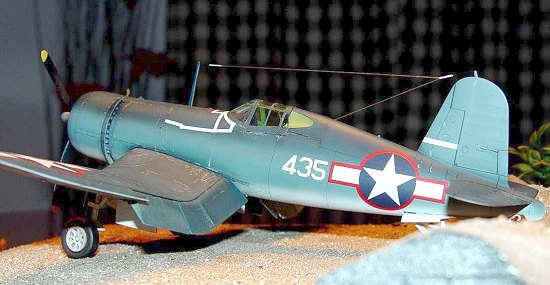 were run down in
the panel lines, left to set for a minute and then wiped down to removed
the excess. To protect the thin finish I then sprayed acrylic satin floor
varnish and allow drying for 24 hours before I started weathering.
were run down in
the panel lines, left to set for a minute and then wiped down to removed
the excess. To protect the thin finish I then sprayed acrylic satin floor
varnish and allow drying for 24 hours before I started weathering.
I weather using a combination of pastels, over spraying with original colors and heavy washes in hard use areas, such as the wheel wells. Then I simulate the chips using a Prisma Color silver pencil and locked the whole finish with a light coat of Testor's Dullcote.
The masking was removed and the landing gear, doors, aerials, pitot tube, propeller were installed and any touch ups that were needed were then done. A final light shading on the fabric areas was applied.
|
FINAL CONSTRUCTION |
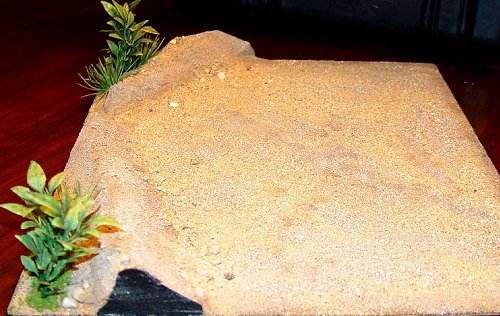 The model is
basically done at this point but it needs something to show it off. I
bought an Imex plastic display case. It was engineered for three 1/18th
diecast cars, but the Corsair fits fine with a little extra room. I made
the embankments using carved Styrofoam and the whole base was then
covered in different grits of sand and dirt. This sand is used material
from salting the roads from winter. It looks just about the right size
and color. I covered the Styrofoam and base with Liquidtex Gel Medium,
sprinkled the sand till I got the texture and set the groundwork with
diluted Elmer's White Glue. The plants came from Hobby Lobby and I
trimmed these to size and then painted them with Windsor & Newton
acrylics to get a more natural look.
The model is
basically done at this point but it needs something to show it off. I
bought an Imex plastic display case. It was engineered for three 1/18th
diecast cars, but the Corsair fits fine with a little extra room. I made
the embankments using carved Styrofoam and the whole base was then
covered in different grits of sand and dirt. This sand is used material
from salting the roads from winter. It looks just about the right size
and color. I covered the Styrofoam and base with Liquidtex Gel Medium,
sprinkled the sand till I got the texture and set the groundwork with
diluted Elmer's White Glue. The plants came from Hobby Lobby and I
trimmed these to size and then painted them with Windsor & Newton
acrylics to get a more natural look.
|
CONCLUSIONS |
I enjoyed this "Quick Build" very much. It gave me the chance to experiment with all these "new fangled" acrylics. The model is now back with Jim. My respect goes to Tamiya in providing a better than average kit.
|
REFERENCES |
F4U in Action, #145 by Jim Sullivan, Squadron Books
Corsair Aces of World War 2 by Mark Styling, Osprey Books
Air War over the Pacific by Robert Stern, Arms and Armour Press
US Naval Aviator 1941-45 by Robert Hargis, Osprey BooksI
November 2003
If you would like your product reviewed fairly and fairly quickly, please contact the editor or see other details in the Note to Contributors.